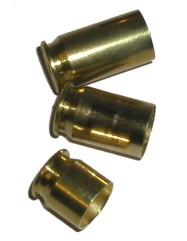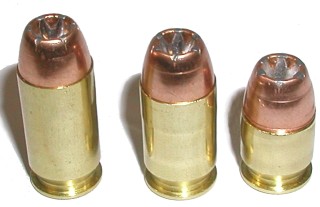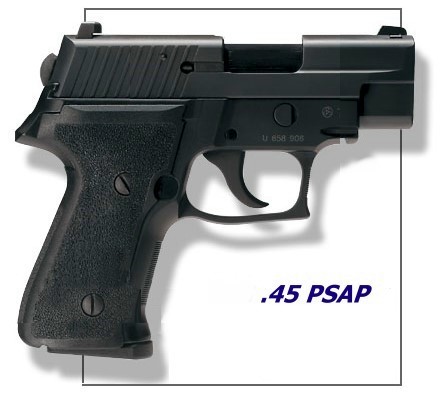
When I first read the May issue of Shooting Times, with its cover .45 GAP headline “GAP Wins!” and related article, I thought “Neat, a new low water mark for how far a publication will go to sell guns and ammo for manufacturers. Within the “apple to apple” comparisons, Shooting Times compared what amounts to a reduced capacity .45 ACP cartridge, operating at .45 ACP +P pressures, to standard and lower pressure factory .45 ACP cartridges. The technical representation was more of the same, where a table compared the two cartridges through dissimilar ammunition types, ammo supplied by companies pushing the new cartridge. Even the test guns were assembled with shorter than typical .45 ACP length barrels, which would obviously favor a lesser capacity cartridge. The author indicated he was shocked that the GAP prevailed, besting the .45 ACP’s performance, something he didn’t believe was possible. Fortunately, engineers from the ammo suppliers ATK (Speer) and Winchester assured him it was so and, as the author put it, “These guys are smart…” Which, I can only assume means the rest of us are not. Now that I’ve had time to reflect….
The .45 Short Automatic Pistol Is Born
 I wanted to be open minded, and not jump to the conclusion that the GAP was perhaps a less than candid way for firearm and ammunition manufacturers to save million per year in material cost, through a few cents per round cost reduction in brass and powder content from every round they sold. Real Guns rolled up its sleeves, especially the right one, and went to work on this concept advanced by Glock and the .45 Glock Automatic Pistol round. The end result is the Real Gun Short Automatic Pistol round. Pictured right – the .45 ACP, .45 GAP and .45 SAP. We found the concept of a shortened case, in fact, had technical merit, offering benefits galore for the average shooter.
I wanted to be open minded, and not jump to the conclusion that the GAP was perhaps a less than candid way for firearm and ammunition manufacturers to save million per year in material cost, through a few cents per round cost reduction in brass and powder content from every round they sold. Real Guns rolled up its sleeves, especially the right one, and went to work on this concept advanced by Glock and the .45 Glock Automatic Pistol round. The end result is the Real Gun Short Automatic Pistol round. Pictured right – the .45 ACP, .45 GAP and .45 SAP. We found the concept of a shortened case, in fact, had technical merit, offering benefits galore for the average shooter.
Burn Superiority

One factor that quickly became apparent was the more we reduced case capacity, the less powder it took to achieve the same velocity, without increasing pressure. The powder charges pictured left, resulted in identical performance, in their respective and labeled cartridges. Hey, we were surprised too. We originally intended to cut a GAP case down from .775″ to .675″. Unfortunately, due to a small adjustment error on our powdered RCBS trimmer, we sailed right through the .675″ length and set .500″ as a maximum case length. As this pressure/volume cause and effect seemed to not fall in nicely with the laws of physics, or even Charles and/or Boyle, we decided to refer to the condition where a small case demonstrates well above 100% efficiency as “Burn Superiority”. So for the time being, the term “BS” will be used until we can get a more defined scientific explanation. Optimized performance was attained with non-conventional propellant. In our case, the lab came up with equal measures of Blue Dot, saw dust and just a dash of oregano. Could have been cheddar, we sometimes we eat lunch in the lab when we run short on time.
P² Primers
 Most of you will know that oregano is a little tough to ignite, I’m pretty sure the kindling temperature is around 6,000°F. For the sake of complete combustion we used a primer developed specifically for this project. In heavier bullet weights, 230 grains and above, the primer actually extends into a recess punched into the heel of the bullet. These primers carry the RG size designation P² or 12 EEE; manufacturer dependent.
Most of you will know that oregano is a little tough to ignite, I’m pretty sure the kindling temperature is around 6,000°F. For the sake of complete combustion we used a primer developed specifically for this project. In heavier bullet weights, 230 grains and above, the primer actually extends into a recess punched into the heel of the bullet. These primers carry the RG size designation P² or 12 EEE; manufacturer dependent.
Comparisons
| Cartridge | Bullet Wgt | MV | ME | Bullet Drop @ 50 Yards |
| .45 SAP | 185 | 900 fps | 333 ft/lbs/liter | -38″ |
| .25 ACP | 50 | 760 fps | 64 ft/lbs/liter | -112″ |
| .32 S&W | 85 | 595 fps | 67 ft/lbs/liter | -739″ |
| .22 Short | 20 | 410 fps | 7 ft/lbs/liter | -1100″ |
| 50 BMG | 750 | 2800 fps | 13,060 ft/lbs/liter | -.025″ |
Clearly illustrated, the SAP outperformed all but one cartridge of similar design and intent. We are working diligently to overtake the last, and we are sure we will eventually get there, but we may need to make the SAP case just a bit shorter. Perhaps a Super Short Automatic Pistol cartridge is in order?
Observations of Unique Characteristics
The SAP bullet is not effected by gravity, unlike most traditional rounds. The bullet leaves the muzzle of the barrel, drops for .2-.3 MS, then rises and flies parallel to the earth for the first 50 feet or so. We think this is a result of the power of a short fat case, similar to pyramid power of the late 1970’s. Recoil is quite modest, in fact it is gentle. Shooting the .45 SAP was not unlike the euphoria of attending Wrestle Mania for those of you who have been spending an excessive amount of time handloading. All I know is, since shooting the .45 SAP, my car gets better gas mileage, my kids stopped making fun of me and my wife thinks I’m a pretty good guy. Wait…yup, my breath is even fresher.
Firearms for the SAP

We tinkered around with one of our SIGs; chopped, channeled and sectioned, until we had a model chambered for the .45 SAP (actual size). We are pretty sure it could be sold on the retail market for about $25. All we need to do is collect our lab data and head for New England and SIG headquarters… We’ll keep you appraised of the law suits.
Thanks,
Joe

Email Notification